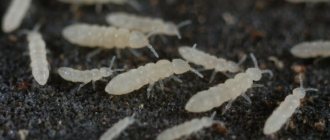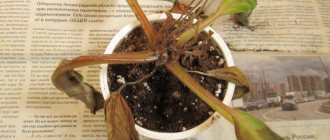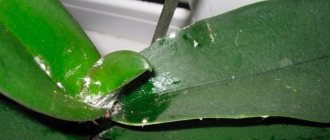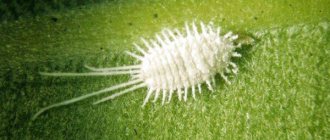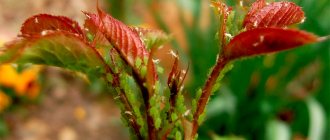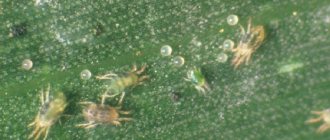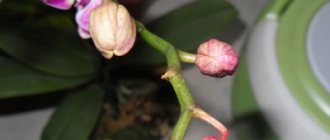Thrips is an insect pest; there are 6 thousand of its species in nature. From an oblong body, no more than 0.3 cm long, it has 6 thin legs.
He prefers indoor plants, one of his favorites being orchids. Questions and problems regarding pest elimination arise among amateur flower growers and professionals with extensive experience. An insect is not limited to one habitat.
Reasons for appearance
Thrips on orchids most often appear with the acquisition of a new plant . A florist can also bring them along with wild and garden flowers. In the photo below you can see the size of these pests.
Basically, thrips appear with the acquisition of a new plant.
Flowers located on the balcony at the height of the first two floors are at risk of infection by this pest.
IMPORTANT! When bringing flowers in after a summer of standing outdoors, you need to inspect them for the presence of pests and take preventive measures.
Description of the adult insect and its larvae
The body length of an adult pest is only 0.5-1.5 mm, the size depends on the subspecies. Thrips are mobile insects , as they have legs equipped with special bubble devices. Why are they classified as bladder-footed? There are wings on the back, but the insect almost never uses them. There is an oral cavity adapted for sucking the juice of the plant.
Thrips development goes through various stages :
- Egg;
- Protonymph;
- Nymph;
- Imago.
The larva resembles an adult thrips, only :
- Painted light brown;
- And it has transparency.
IMPORTANT! In a year, in good housing conditions, up to 12 generations of the pest can grow.
Thrips development stages.
Life cycle
Depending on the species, thrips differ significantly from each other. The length of insects varies from 0.5 to 5 mm. Some of them have wide, fringed wings, others are short and underdeveloped.
There are species of thrips that have no wings at all. The female lays eggs in small crevices of leaves, stems and flowers. The female can lay eggs all year round, because in a warm room the eggs ripen in a few days.
Thrips take 7 days to arrive as young nymphs, during which time they have a pale green or cream color. As the nymphs mature, they burrow into the soil to later pupate. The development of thrips from nymph to adult takes 20 days. Winged thrips emerge from the dolls and complete their life cycle. Juveniles differ from adults in the absence of wings - they develop gradually.
After leaving the cocoon, the insect begins to feed on the plant on which it was deposited.
The life cycle of thrips depends on the environment (temperature). When reaching 20 °C, the insect lives 20-22 days, at a temperature of 25 °C - 15-18 days. A fast life cycle indicates frequent generation changes, so the interval between primary and re-treatment should be short.
What is their danger?
The insect is very small in size, and while on the plant, they actively feed on its sap . Thrips carry various viruses and infections. Also, while on the orchid, they cover its leaves with a coating, which in turn:
- Prevents oxygen from entering plant cells;
- And it disrupts the process of photosynthesis.
The plant's immunity is noticeably reduced and the plant is attacked by fungi , which complete the death of the flower. Also, if there is damage on the buds in the form of small dark dots, then this is the appearance of thrips.
Thrips carry many different diseases and infections.
You can detect thrips by carefully examining the plant. If black dots are found on its leaf plates and the leaf is covered with a silvery coating, then this is a waste product of a pest. A noticeable signal of infection will be curved :
- Peduncles;
- New leaves;
- Underdeveloped buds.
Having seen these main signs, you need to carefully examine the plant, and then you will probably be able to notice the culprit of the damage to the orchid. After which treatment begins immediately .
What thrips look like - description with photo
What do thrips look like? You can study the description below, and in addition, see photos of these insects. They were first discovered and described by Karl de Geer in 1744; the original name of thrips was Physapus. In 1758, naturalist Karl Lynn gave them the modern name you know, thrips. Thrips are one of the most ancient insects; it is believed that they are the ancestors of all bugs. A description of the structure of the body will help to distinguish this pest from others. The length of an adult individual reaches 1.4 mm; there are individuals with a curved tail, their length reaches 2 mm. Insects are mobile thanks to thin legs with suction devices and a tooth at the ends, yellow-brown wings with distinct villi. The mouthparts have three piercing bristles, thanks to which thrips feed on the plant.
There are a huge number of varieties of thrips. Four species of thrips, described below, pose a danger to orchids. Wings are not developed in all birds, but only in grain ones. Bread thrips can move in clouds from field to field. Fortunately, these thrips are not dangerous to the orchid.
- The most dangerous species is the Californian (western), common in the western regions of Europe. The parasite is practically omnivorous and destroys ornamental and flower plants, vegetable plantings, and fruit-bearing trees. The insect is a carrier of a huge number of threats to a healthy plant.
- Tobacco - also known as onion thrips, imago. A miniature, inconspicuous insect that causes enormous damage to orchids. The body length of the insect is up to 1.3 mm, the color of chitin is from light brown to black.
- American - found relatively recently - in the 90s on young shoots of miltonia and a recently obtained spathoglottis hybrid, is dangerous for orchids.
- Dracaena is a parasite with a black and white body up to 1.3 mm long. The color of the larvae is transparent white. Frequent inhabitant of orchid leaf blades.
In order not to infect your favorite orchid, it is enough to follow some rules, which you will learn about later.
Fighting methods
Many beginners ask the question: how to get rid of thrips on an orchid? There are various ways and we will tell you about some of them.
Folk remedies
If the lesion is small or at this moment the grower for a number of reasons cannot use other means, you can try to get rid of the pest using folk remedies.
Soap solution
Take small natural laundry soap 72% and grate it.
When controlling pests, the orchid is sprayed with a soap solution.
Then it is mixed with warm water and is treated with this solution .
After using the solution, rinse it off with warm water after 15 minutes. Soap can also damage the leaves of the plant.
Reader's opinion: No folk remedies, let alone soap, will help get rid of thrips!
Tobacco tincture
To get rid of thrips, 100 gr. tobacco is brewed in a liter of water, infused for 24 hours and filtered. After that, treatments are carried out several times to make sure that the pest is defeated.
Decoction of Tagetes (Marigold)
The inflorescences are crushed, no more than 100 g. pour in a liter of water and bring to a boil. After that, turn off the fire, wrap the container with marigolds in a towel and let it brew for 3 days. After this time, the infusion is ready for use against thrips.
If folk remedies do not help in the fight against harmful insects, it must be removed in other ways . Also, folk remedies can spoil the appearance of the plant, as it clogs the leaves and they begin to deform.
Biological agents
In specialized stores you can find various biological preparations that contain predatory insects :
- Klopov;
- Ticks.
They are poured from a bag or test tube onto a damaged orchid, where they feed on thrips until they are completely destroyed.
Now many European companies produce biological products to combat pests, as they :
- Are effective;
- And they do not harm the environment.
These are predatory insects :
- Thrips Franklinothrips vespiformis;
- Orius bug.
The bug is one of the biological methods of destroying thrips.
These types of insects have come to be considered useful and are used in greenhouses to destroy common thrips.
IMPORTANT! But do not forget about preventive measures and place purchased plants in the quarantine zone.
Chemicals
The chemical industry has created many drugs that can remove thrips from a plant. They come in various forms :
- Granules;
- Powders;
- Emulsions that dissolve well in water.
Experienced gardeners often use :
- Aktar;
- Fitoverm ( insecticide
of contact-intestinal action).
These are drugs that effectively destroy the pest and do not cause harm to humans and their pets.
When diluting these drugs, you must follow the instructions and do not increase the dose. Also, the number of treatments should not deviate from what is indicated in the instructions on the package.
There are also many different drugs that can destroy thrips:
- Celaflor;
- Vertimek;
- Neudorf;
- Aktellik;
- Pyrethrum powder.
IMPORTANT! It must be remembered that treatments are carried out until the pest completely disappears. And if one drug does not help, you need to take another with a different active ingredient.
Risk level
Many chemicals are oil-based , which helps in fighting insects by blocking their airways. But this is also harmful for the leaf blades because without access to oxygen they cease to participate in the process of photosynthesis, which has a bad effect on the life of the orchid. The delicate leaves of certain types of orchids are especially affected.
We must not forget that chemicals also harm the orchid.
Therefore, the preparations must be used carefully, and if the appearance of the plant begins to deteriorate, you must :
- Change the drug;
- Or stop processing with chemicals altogether;
- And switch to folk remedies.
Experienced flower growers advise not to spray the preparations on the entire orchid, but to apply them pointwise to those places where the pest is noticed. This is necessary so that the plant has leaves that can engage in the process of photosynthesis.
Spider mite
If a thin cobweb appears on the flowers and buds or on the underside of the leaves of the orchid, it means that the plant is damaged by spider mites. It is especially noticeable when spraying, so this procedure should not be neglected when caring for flowers. A more advanced stage of damage is pale yellow spots, as well as curled and drying leaves.
Like many orchid pests, spider mites suck the juices out of the plant, causing it to soon die. These insects are truly insidious: it is very difficult to notice them in the first stages. And in the later stages it is already difficult to restore the plant, since the orchid, in addition to everything else, is affected by fungi - black spots form on the leaves. Spider mites love young and soft leaves most of all. But this does not mean that they are limited to them.
Reason for appearance
Spider mites pose a danger primarily to those orchids that are kept in a room with very dry and warm air.
How to get rid of spider mites
The first thing to do if mites are found on an orchid is to wash the outer part of the plant with water and laundry soap or dishwashing detergent (1 tablespoon per 1 liter of warm water). This treatment will not destroy all insects, but at least it will help to significantly reduce their number.
At the same time, it is worth treating the place where the orchid stood, as well as the pot and stand.
Then the orchid needs to be watered well and placed in a transparent bag for 3 days. This will significantly increase the air humidity around the flower and destroy the remaining mites. The orchid in the bag must be closely monitored so that it does not suffer from the increased temperature inside the homemade greenhouse.
Spider mites are very resilient and quickly develop immunity to chemicals. Therefore, when using insecticides to combat this pest, they should be alternated. Suitable for processing BioKill, Fitoverm, Neoron orchids.
Spider mite on an orchid leaf
Folk remedies
If you do not want to use chemicals in the fight against spider mites, you can prepare a decoction of cyclamen tubers. To do this, the tubers of the plant need to be cut into several parts and boiled in boiling water for about 40 minutes. After this, the broth should be allowed to brew for a day, and then strain it through cheesecloth or a sieve. You need to spray the orchid with a decoction of cyclamen tubers several times with an interval of 5 days.
Another good tool in the fight against ticks is medical alcohol. But it is only suitable for orchids with hard leaves (for example, Cattleya). The green mass of the plant should be wiped with a piece of cotton wool soaked in alcohol. In order not to burn the orchid, you first need to treat a small area of the leaf and look at the reaction of the flower.
Frequent spraying is the most reliable prevention of spider mites
However, when carrying out this procedure, it is extremely important to ensure that water does not linger in the axils of the leaves - otherwise the plant may rot
Prevention measures
First of all, newly purchased orchids are placed in a quarantine zone for 2 weeks to make sure that the plant is not infected with harmful insects.
Preventive measures:
- Quarantine measures;
- Warm shower for plants;
- Carrying out scheduled treatment before the winter period;
- Periodically inspect your collection for pests.
Important! When “bathing” phalaenopsis in the shower, water gets into the axils of the leaves, which can lead to rotting and death of the plant, so the water in the axils should be immediately blotted with cotton pads.
Preventive measures
To protect your orchids from thrips infection, it is recommended to follow these tips:
- send newly purchased orchids to a two-week quarantine;
- disinfect the purchased substrate - in the oven or freezer;
- Give the plant a warm shower every 2-4 weeks;
- maintain an optimal humidity level for orchids;
- after the budding period, carry out preventive treatments;
- regularly inspect the crop for damage.
It is possible to save an orchid from a thrips attack. But in order to notice parasites in time and begin resuscitation of the crop, it is necessary to regularly inspect the plant.
Other methods for preventing the appearance of thrips on orchids:
- Since thrips love dry air, they will not reproduce in humid air, so reasonable humidification ;
- Sticky insect can be
- Replanting the purchased plant is required. This will help not only prevent rot on the root mass, but also remove pests found in the substrate.
